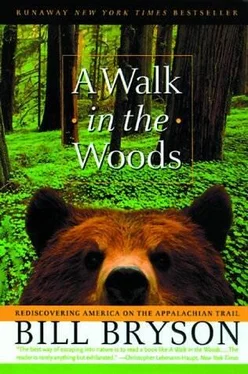Bill Bryson - A Walk In The Woods
Здесь есть возможность читать онлайн «Bill Bryson - A Walk In The Woods» весь текст электронной книги совершенно бесплатно (целиком полную версию без сокращений). В некоторых случаях можно слушать аудио, скачать через торрент в формате fb2 и присутствует краткое содержание. Жанр: Современная проза, на английском языке. Описание произведения, (предисловие) а так же отзывы посетителей доступны на портале библиотеки ЛибКат.
- Название:A Walk In The Woods
- Автор:
- Жанр:
- Год:неизвестен
- ISBN:нет данных
- Рейтинг книги:4 / 5. Голосов: 1
-
Избранное:Добавить в избранное
- Отзывы:
-
Ваша оценка:
- 80
- 1
- 2
- 3
- 4
- 5
A Walk In The Woods: краткое содержание, описание и аннотация
Предлагаем к чтению аннотацию, описание, краткое содержание или предисловие (зависит от того, что написал сам автор книги «A Walk In The Woods»). Если вы не нашли необходимую информацию о книге — напишите в комментариях, мы постараемся отыскать её.
A Walk In The Woods — читать онлайн бесплатно полную книгу (весь текст) целиком
Ниже представлен текст книги, разбитый по страницам. Система сохранения места последней прочитанной страницы, позволяет с удобством читать онлайн бесплатно книгу «A Walk In The Woods», без необходимости каждый раз заново искать на чём Вы остановились. Поставьте закладку, и сможете в любой момент перейти на страницу, на которой закончили чтение.
Интервал:
Закладка:
Still, Kittatinny Mountain, towering above the river on the New Jersey side, is a compelling sight, and you can’t look at it (at least I couldn’t, at least not this day) without wanting to walk up it and see what is there. I parked at an information center at its base and set off into the welcoming green woods. It was a gorgeous morning-dewy and cool but with the kind of sunshine and sluggish air that promises a lot of heat later on-and I was early enough that I could get almost a full day’s walk in. I had to get the car home to New Hampshire by the following day, but I was determined to get at least one decent walk in, to salvage something from the catastrophe that was this trip, and luckily I seemed to have chosen well. I was in the midst of several thousand acres of exquisitely pretty woodlands shared jointly by Worthington State Forest and the Delaware Water Gap National Recreation Area. The path was well maintained and just steep enough to feel like healthful exercise rather than some kind of obsessive torture.
And here was a final, joyful bonus: I had excellent maps. I was now in the cartographically thoughtful hands of the New York-New Jersey Trail Conference, whose maps are richly printed in four colors, with green for woodland, blue for water, red for trails, and black for lettering. They are clearly and generously labeled and sensibly scaled (1:36,000), and they include in full all connecting roads and side trails. It is as if they want you to know where you are and to take pleasure in knowing it.
I can’t tell you what a satisfaction it is to be able to say, “Ah! Dunnfield Creek, I see,” and, “So that must be Shawnee Island down there.” If all the AT maps were anything as good as this, I would have enjoyed the experience appreciably more-say, 25 percent more. It occurred to me now that a great part of my mindless indifference to my surroundings earlier on was simply that I didn’t know where I was, couldn’t know where I was. Now at last I could take my bearings, perceive my future, feel as if I was somehow in touch with a changing and knowable landscape.
And so I walked five thoroughly agreeable miles up Kittatinny to Sunfish Pond, a very comely forty-one-acre pond surrounded by woods. Along the way, I encountered just two other people-both day hikers-and I thought again what a stretch it is to suggest that the Appalachian Trail is too crowded. Something like thirty million people live within two hours’ drive of the Water Gap-New York was just seventy miles to the east, Philadelphia a little bit more to the south-and it was a flawless summer’s day, yet the whole of this majestic woods belonged to just three of us.
For northbound hikers Sunfish Pond is something of a glorious novelty, since nowhere south of here will you find a body of water on a mountaintop. It is in fact the first glacial feature northbound hikers come across. During the last ice age, this was about as far as the ice sheets got. The farthest advance in New Jersey was about ten miles south of the Water Gap, though even here, where the climate would let it go no farther, it was still at least 2,000 feet thick.
Imagine it-a wall of ice nearly half a mile high, and beyond it for tens of thousands of square miles nothing but more ice, broken only by the peaks of a very few of the loftiest mountains. What a sight that must have been. And here is a thing that most of us fail to appreciate: we are still in an ice age, only now we experience it for just part of the year. Snow and ice and cold are not really typical features of earth. Taking the long view, Antarctica is actually a jungle. (It’s just having a chilly spell.) At the very peak of the last ice age 20,000 years ago, 30 percent of the earth was under ice. Today 10 percent still is. There have been at least a dozen ice ages in the last two million years, each lasting about 100,000 years. The most recent intrusion, called the Wisconsinian ice sheet, spread down from the polar regions over much of Europe and North America, growing to depths of up to two miles and advancing at a rate of up to 400 feet a year. As it soaked up the earth’s free water, sea levels fell by 450 feet. Then, about 10,000 years ago, not abruptly exactly but near enough, it began to melt back. No one knows why. What it left in its wake was a landscape utterly transformed. It dumped Long Island, Cape Cod, Nantucket, and most of Martha’s Vineyard where previously there had just been sea, and it gouged out the Great Lakes, Hudson Bay, and little Sunfish Pond, among much else. Every foot of the landscape from here on north would be scored and scarred with reminders of glaciation-scattered boulders called erratics, drumlins, eskers, high tarns, cirques. I was entering a new world.
No one knows much of anything about the earth’s many ice ages-why they came, why they stopped, when they may return. One interesting theory, given our present-day concerns with global warming, is that the ice ages were caused not by falling temperatures but by warming ones. Warm weather would increase precipitation, which would increase cloud cover, which would lead to less snow melt at higher elevations. You don’t need a great deal of bad weather to get an ice age. As Gwen Schultz notes in Ice Age Lost, “It is not necessarily the amount of snow that causes ice sheets, but the fact that snow, however little, lasts.” In terms of precipitation, she observes, Antarctica “is the driest large area on Earth, drier overall than any large desert.”
Here’s another interesting thought. If glaciers started reforming, they have a great deal more water now to draw on-Hudson Bay, the Great Lakes, the hundreds of thousands of lakes of Canada, none of which existed to fuel the last ice sheet-so they would grow very much quicker. And if they did start to advance again, what exactly would we do? Blast them with TNT or maybe nuclear warheads? Well, doubtless we would, but consider this. In 1964, the largest earthquake ever recorded in North America rocked Alaska with 200,000 megatons of concentrated might, the equivalent of 2,000 nuclear bombs. Almost 3,000 miles away in Texas, water sloshed out of swimming pools. A street in Anchorage fell twenty feet. The quake devastated 24,000 square miles of wilderness, much of it glaciated. And what effect did all this might have on Alaska’s glaciers? None.
Just beyond the pond was a side trail, the Garvey Springs Trail, which descended very steeply to an old paved road along the river, just below a spot called Tocks Island and which would take me in a lazy loop back towards the visitor center where I had left the car. It was four miles and the day was growing warm, but the road was shaded and quiet-I saw only three cars in an hour or so-so it was a pleasant stroll, with restful views of the river across overgrown meadows.
By American standards, the Delaware is not a particularly imposing waterway, but it has one almost unique characteristic. It is nearly last significant undammed river in the United States. Now this might seem an inestimable virtue-a river that runs as nature planned it. However, one consequence of its unregulated nature is that the Delaware regularly floods. In 1955, as Frank Dale notes in his excellent book Delaware Diary, there was a flood that even now is remembered as “the Big One.” In August of that year-ironically at the height of one of the most severe droughts in decades-two hurricanes hit North Carolina one after the other, disrupting and enlivening weather all up and down the East Coast. The first dumped ten inches of rain in two days on the Delaware River Valley. Six days later the valley received ten inches in less than twenty-four hours. At a place called Camp Davis, a holiday complex, forty-six people, mostly women and children, took refuge from the rising flood waters in the camp’s main building. As the waters rose, they fled first upstairs and then into the attic, but to no avail. Sometime in the night a thirty-foot wall of water came roaring through the valley and swept the house away. Amazingly, nine people survived.
Читать дальшеИнтервал:
Закладка:
Похожие книги на «A Walk In The Woods»
Представляем Вашему вниманию похожие книги на «A Walk In The Woods» списком для выбора. Мы отобрали схожую по названию и смыслу литературу в надежде предоставить читателям больше вариантов отыскать новые, интересные, ещё непрочитанные произведения.
Обсуждение, отзывы о книге «A Walk In The Woods» и просто собственные мнения читателей. Оставьте ваши комментарии, напишите, что Вы думаете о произведении, его смысле или главных героях. Укажите что конкретно понравилось, а что нет, и почему Вы так считаете.












